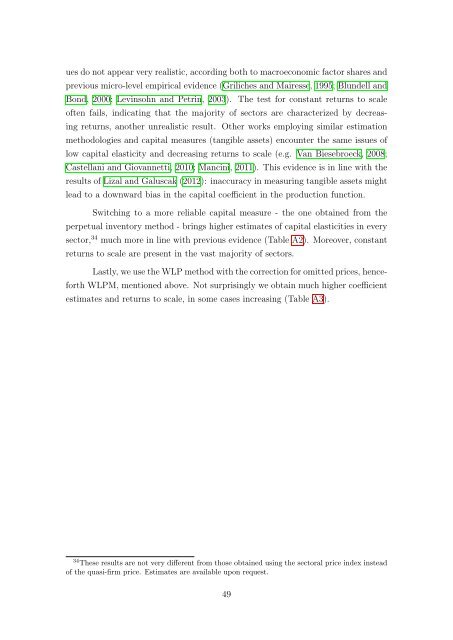n?u=RePEc:bdi:wptemi:td_1011_15&r=eff
n?u=RePEc:bdi:wptemi:td_1011_15&r=eff
n?u=RePEc:bdi:wptemi:td_1011_15&r=eff
- No tags were found...
Create successful ePaper yourself
Turn your PDF publications into a flip-book with our unique Google optimized e-Paper software.
ues do not appear very realistic, according both to macroeconomic factor shares andprevious micro-level empirical evidence (Griliches and Mairesse, 1995; Blundell andBond, 2000; Levinsohn and Petrin, 2003). The test for constant returns to scaleoften fails, indicating that the majority of sectors are characterized by decreasingreturns, another unrealistic result. Other works employing similar estimationmethodologies and capital measures (tangible assets) encounter the same issues oflow capital elasticity and decreasing returns to scale (e.g. Van Biesebroeck, 2008;Castellani and Giovannetti, 2010; Mancini, 2011). This evidence is in line with theresults of Lizal and Galuscak (2012): inaccuracy in measuring tangible assets mightlead to a downward bias in the capital coefficient in the production function.Switching to a more reliable capital measure - the one obtained from theperpetual inventory method - brings higher estimates of capital elasticities in everysector, 34 much more in line with previous evidence (Table A2). Moreover, constantreturns to scale are present in the vast majority of sectors.Lastly, we use the WLP method with the correction for omitted prices, henceforthWLPM, mentioned above. Not surprisingly we obtain much higher coefficientestimates and returns to scale, in some cases increasing (Table A3).34 These results are not very different from those obtained using the sectoral price index insteadof the quasi-firm price. Estimates are available upon request.49



